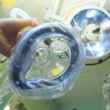Transcatheter aortic valve replacement (TAVR) results durable at 5 years to treat failed surgical bioprosthetic valves and at one year to treat valves percutaneously. Regardless the type of the failed valve, the solution is TAVR. The 5 year follow up of the PARTNER 2 valve-in-valve (ViV) showed that TAVR as treatment for failed surgical bioprosthetic...
TCT 2020 | Surprising Differences in Stroke between SAPIEN 3 and Evolut R
One-year outcomes of the head to head trial between CoreValve Evolut R vs Sapien 3 showed a significantly higher difference in stroke vs. patients receiving the self-expanding valve (Sapien 3 6.9% vs Evolut R 1%; p=0.002). The SOLVE-TAVI randomized 2×2 patients with severe aortic stenosis and high surgical risk to Sapien 3 or Evolut R and...
TCT 2020 | Efficacy of Cerebral Protection Device TriGUARD 3 During TAVR
Cerebral protection device TriGUARD 3, designed to cover all supra-aortic vessels during transcatheter aortic valve replacement (TAVR), is safe to use, according to the outcomes of the REFLECT II study. The technical feasibility of the device, which requires transfemoral access, does not seem to have an impact over clinical events. The primary safety endpoint was a VARC-2-defined...
Death, Stroke, and Hospitalization while Waiting for TAVR
The consequences of deferring transcatheter aortic valve replacement (TAVR) procedures because of the COVID 19 pandemic are piling up. Untreated severe aortic stenosis patients who had been scheduled for TAVR are seeing increased risk of all events, even mortality. According to recent studies published in JAMA, deferring TAVR in patients with symptomatic aortic stenosis is...
Post TAVR ASA Monotherapy Consolidates
This meta-analysis to be published in J Am Cardiol supports the use of aspirin monotherapy (ASA) after transcatheter aortic valve replacement (TAVR). The use of aspirin alone is associated to less bleeding without increased ischemic events such as strokes or mortality. The combined outcomes of four studies, including the recently published POPular TAVI (cohort A),...
Minimalist TAVR to the Max
Transcatheter aortic valve replacement (TAVR) is increasingly being performed under conscious sedation, which is associated with a multi-point benefit (including mortality). This paper, recently published in JACC Intv., shows that general anesthesia is becoming obsolete, although the magnitude the benefit derived from conscious sedation appears to be lower than in previous studies. The aim of...
TAVR as Anti-Inflammatory? An effect few imagined
We never saw it coming, such a pleiotropic effect: who would have though a mechanical device could have such a systemic anti-inflammatory effect? Transcatheter aortic valve replacement (TAVR) does in fact have it. The shear stress aortic stenosis produces activates multiple inflammatory responses mediated by monocytes. This study identified the most important mechanoreceptor, involved in...
Considerations for Optimal Device Selection in TAVR
Many studies have tried to answer the question about whether there is a superior device in transcatheter aortic valve replacement (TAVR). Today, there is no evidence to support such claim, and most patients will likely find operator experience more beneficial than any device per se. However, there are certain patients with specific characteristics that might...
TAVR After Endocarditis? Contraindication or Last Resort
Transcatheter aortic valve replacement (TAVR) can be an alternative for aortic valves with endocarditis successfully treated with antibiotics, which no longer are severe valve lesions. At one year, the risk of endocarditis relapse was low and the mortality rate was similar to that of patients without a history of infection. This aim of this study...
Same Contrast Dose, Different Risk of Kidney Injury, Depending on Procedure
The risk of contrast induced kidney injury is significantly lower in patients receiving transcatheter aortic valve replacement (TAVR) compared against patients getting a coronary angiography or angioplasty. This is true even for valvular heart disease patients with higher risk profiles. Differences in contrast-induced acute kidney injury between TAVR or coronary patients had not been previously...









